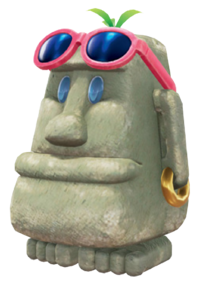Moe-Eye
| Moe-Eye | |||
|---|---|---|---|

| |||
| Appears in | Super Mario Odyssey (2017) | ||
| |||
Moe-Eyes are a species from Super Mario Odyssey that can be captured with Cappy. They are based on their namesake, the moai statue heads, and each has a pair of feet, a pair of earrings, a pair of sunglasses, and a tuft of green hair. Moe-Eyes are found in the Moe-Eye Habitat, the Transparent Maze of the Sand Kingdom, and the Underground Moon Caverns in the Moon Kingdom. They are always seen looking at Mario, briefly taking their eyes off him for their idle animation. They do not move by default. If Mario comes closer, Moe-Eyes panic. They shift their sunglasses upward and try to run away. They are unable to walk off most ledges. When they are unable to move forward, Moe-Eyes switch to moving parallel to the ledge or wall. Moe-Eyes are fully immune to cacti, and they kick away any of the smaller variation they touch. The panicking state resets quickly, but if Mario is still in their radius, it will restart instantly.
When a Moe-Eye is captured by Mario, the player can put on or take off the sunglasses by pressing or
. While the sunglasses are on, the player is able to see Transparent Platforms, invisible coins, and Hidden Blocks. The player can also see a pillar of light from the locations of underground Power Moons, even those that do not have a corresponding glowing spot. (As with other light pillars in Super Mario Odyssey, the light is less intense if the player is close to the source.) Moe-Eyes walk much slower than normal while wearing the sunglasses. (The player can capture a Moe-Eye while its sunglasses are still on, but the Moe-Eye takes its glasses off just after being captured, so the game functionally defaults to having glasses off.)
Moe-Eyes are unable to jump, with the respective buttons also using their sunglasses. In addition, Moe-Eyes plummet directly off the edges of platforms with no ability to change trajectory. As such, Mario has to use elevators to access higher platforms, or in some cases, he has to first use a Moe-Eye to see invisible platforms that must be jumped to, then navigate after releasing the Moe-Eye. Mario can still use the cacti immunity.
A captured Moe-Eye can be heard faintly humming the first few notes of the "Ground Theme" or the "Ending" theme from Super Mario Bros., the Super Mario World "Ending" theme, "Gusty Garden Galaxy" from Super Mario Galaxy, or another unknown theme[1] while the sunglasses are on.
Despite being harmless, Moe-Eyes return with the same purple effect that signifies a respawning enemy after they are defeated by poison, lava, or pits. Additionally, NPCs are not frightened by Moe-Eyes but are frightened by captured Moe-Eyes. This can be shown if Mario flies near their habitat as Glydon, who will tell the Moe-Eyes to stay away if Mario captures one.[2]
Concept and creation[edit]
The design of Moe-Eyes used peculiar textures that would make them easily distinguishable from the ruins of Tostarena.[3] Great care was poured into getting an appropriate appearance of the forehead, although this is typically not visible during the game.[3]
Profiles[edit]
- Website bios
- Japanese: つぶらな瞳がチャームポイント。メガネをかければ、見えないものもバッチリ見えちゃう。[4] (Their round eyes are their charm. When wearing glasses, they can see invisible things perfectly.)
- English: Give a wiggle of its magical shades, and the Moe-Eye can reveal hidden objects and new paths to explore.[5]
Gallery[edit]
Naming[edit]
"Moe-Eye" is a pun on "moai" and "eye," as well as the given name "Moe."
Internal names[edit]
| Game | File | Name | Meaning
|
|---|---|---|---|
| Super Mario Odyssey | ObjectData/Megane.szs | Megane | Romanization of「眼鏡」(spectacles), referring to its eyewear |
Names in other languages[edit]
| Language | Name | Meaning | Notes |
|---|---|---|---|
| Japanese | ミルゾウ[6] Miruzō |
Portmanteau of「見る」(miru, to see) and「像」(zō, statue) | |
| Chinese (simplified) | 观像[?] Guān xiàng |
Literally "looking statue" | |
| Chinese (traditional) | 看看像[?] Kàn kàn xiàng |
Literally "looking statue" | |
| Dutch | Moe-Eye[?] | - | |
| French | Ma'tuvu[7] | Pun on m'as-tu vu ("did you see me?") | |
| German | Röntgolith[?] | From röntgen ("x-ray") and "-lith" | |
| Italian | Spionelito[?] | From spione (a colloquialism of "spy") and -lito ("-lith") | |
| Korean | 볼테다[?] Bolteda |
Literally means "dare to see" | |
| Russian | Глазолит[?] Glazolit |
From глаз (glaz, eye) and -лит (-lit, "-lith") | |
| Spanish (NOA) | Mo-guay[?] | Portmanteau of "moai" and guay ("cool") | |
| Spanish (NOE) | Mo-Guay[?] | Same as the NOA Spanish name |
References[edit]
- ^ Thomas Game Docs (May 8, 2022). Nintendo’s music is FULL of hidden secrets. YouTube. Retrieved May 23, 2022.
- ^ SenderwalkTest. (November 28, 2020). SenderwalkTest on Twitter: "The Super Mario Wiki needed some sourcing. This video should do the trick. #SuperMarioOdyssey #NintendoSwitch". Twitter. Retrieved November 28, 2020.
- ^ a b Post about the concept art of a Moe-Eye from the Japanese Super Mario Odyssey official Twitter account. Retrieved January 23, 2018.
- ^ https://www.nintendo.co.jp/switch/aaaca/action/index.html
- ^ https://www.nintendo.co.uk/Games/Nintendo-Switch-games/Super-Mario-Odyssey-1173332.html#Meet_Cappy
- ^ Sakai, Kazuya, and kikai, editors (2018). 『スーバーマリオ オデッセイ 公式設定資料集』. Tokyo: ambit (Japanese). ISBN 978-4-19-864696-7. Page 115.
- ^ Official French Super Mario Twitter



